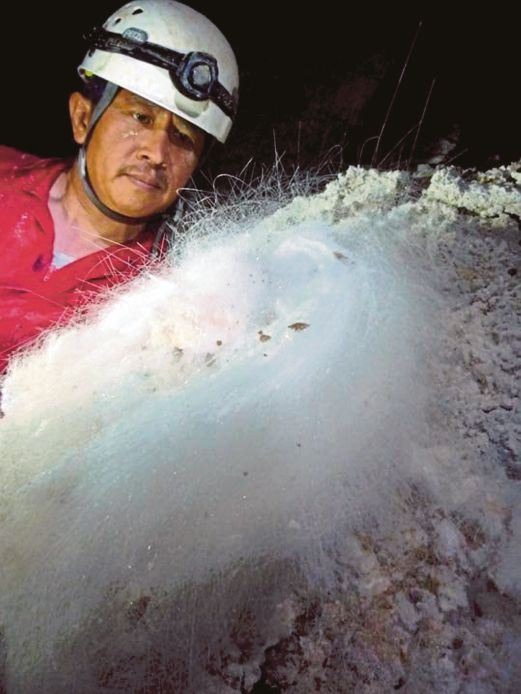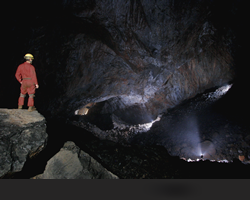
Jangkitan 'MFD' amat ditakuti peneroka gua
Rambli tahan sakit lapan jam lengkapkan ekspedisi singkap misteri Whiterock
Dalam komuniti peneroka dan penyelidik gua antarabangsa, Gua Mulu tidak sekadar dikenali sebagai gua terbesar dan tercantik di dunia, malah turut digeruni berikutan wujudnya jangkitan 'Mulu Foot Diseases' (MFD).
Bagi mana-mana individu yang terkena jangkitan itu, ia tidak berbahaya, namun cukup menyakitkan kerana boleh membuatkan kulit dan tapak kaki menjadi nipis, sebelum bertukar menjadi tompok kemerahan yang memedihkan.
Malah, apabila terpijak sebarang objek keras, kesannya seolah-olah terkena renjatan elektrik, sekali gus membataskan pergerakan sehingga boleh menyebabkan misi penerokaan terpaksa ditangguh atau dibatalkan.
Ia diakui penjelajah veteran, Rambli Ahmad,54, yang terpaksa menahan sakit lebih lapan jam selepas terkena jangkitan itu ketika menyertai ekspedisi Gua Whiterock di Taman Negara Mulu, sebelum ini.
Malah, pengalaman itu pasti tidak dilupakan 'Indiana Jones Sarawak' apabila berdepan ancaman spesies kulat yang memakan kulit kakinya selepas menghabiskan banyak masa dalam gua dan tidak terdedah kepada cahaya matahari serta udara segar.
"Ia tidaklah mengancam nyawa tetapi cukup memeritkan. Tempoh lapan jam menahan sakit pada tapak kaki itu cukup menyeksakan, malah turut membataskan pergerakan. Namun, saya ketepikan rasa sakit itu untuk menyelesaikan ekspedisi,' katanya dalam temu bual bersama BH.
Ketika dunia terpukau dengan penemuan gua baharu, Gua Conviction di Taman Negara Mulu, Miri, akhir tahun lalu, tidak ramai mengetahui mengenai kewujudan Gua Whiterock yang dipercayai gua kristal tercantik dan terbesar di taman negara berkenaan.
Ia ditemui Matt Kirby dan Richard Chambers, dengan ekspedisi berkenaan turut mendapat bantuan Rambli.
Terletak 2.5 kilometer dari Melinau Gorge, gua berkenaan mendapat namanya daripada tebing putihnya yang cukup memukau.

'Ia sungguh unik kerana di sekelilingnya penuh sulfur yang menyebabkan dinding, debu dan lantainya berwarna putih. Pemandangannya cukup memukau," katanya.
Rambli berkata, ketika mengikuti ekspedisi bersama ahli geologi, Hugh St Lawrence dan Gina Moseley, mereka turut mencipta sejarah apabila menemui aliran sungai bawah tanah di Gua Whiterock.
Pada 8 Mac 2011, kami meneroka lubang kecil yang jika dilihat dari luar, bagai tidak memberi sebarang harapan. Namun, disebabkan rasa teruja yang begitu tinggi, kami terus melakukan penerokaan. Kami memasuki lubangn sempit itu dan ia perjalanan yang berbaloi.
"Di bawahnya, kami menemui keindahan gumpalan kapas sulfur yang indah dan licin yang dinamakan Ski Wednesday kerana rupanya seperti salji. Selepas berehat seketika, penjelajahan diteruskan di lokasi berkenaan yang belum pernah dimasuki manusia," katanya.

Ketika hampir mengalah dalam misi pencariannya, penjelajah veteran itu bersama rakan ekspedisinya berasakan tiupan angin dari bahagian dalam lubang berkenaan, sekali gus memberi semangat kepada mereka meneruskan usaha berkenaan.
"Apabila saya bertemu St Lawrence dan Moseley, mereka memberitahu kawasan penerokaan mereka sudah sampai ke penghujung, malah tiada sebarang penemuan baharu. Laluan penerokaan saya pula semakin mengecil, namun saya dapat berasakan tiupan angin dan udara yang agak segar.
"Mereka cukup teruja selepas dimaklumkan mengenai perkara itu. Lalu, kami terus merangkak ke dalam laluan sempit itu sebelum ia menjadi semakin luas. Kemudian, bunyi aliran air yang membawa kepada penemuan sungai bawah tanah yang cukup uni dan belum tercemar," katanya.
Sumber : Berita Harian
Tarikh : 3 Januari 2017
Ditulis oleh : Rudi Affendi Khalik

'MFD' infection is a dreaded by cave explorer
Rambli have to bear pain for eight hours to complete the mission to disclose the mystery of Whiterock
Within the explorer and cave researchers communities, Mulu Cave is more than just the biggest and the most beautiful cave in the world. It also dreaded for an infection called 'Mulu Foot Diseases' (MFD).
It's not a dangerous infection but very painful because it could cause foot and sole to thin before it changes to become painful red spots.
The pain will escalate as though as has been electrocuted if accidentally stepped on hard surface that will limits the movement that could cause the expedition to be postponed or cancelled.
This was admitted by a veteran explorer, Rambli Ahmad, 54, who have to endure pain for more than eight hours after being infected by 'MFD' during participating in search of Whiterock Cave in Taman Negara Mulu.
It's an unforgettable experience for the 'Sarawak Indiana Jones' when being infected with this skin eating fungus after being in the cave for too long and has not been exposed to sunlight and fresh air.
"It's not life-threatening disease but it's too painful. Eight hours of enduring sole pain was unbearable and it limits your movement. However, I didn't take it a big deal because I want to complete the expedition," he said in an interview with BH.
While the world was mesmerized with the latest cave discovery of Gua Conviction in Taman Negara Mulu, Miri at the end of last year, not many realized the existence of Gua Whiterock that is believed to be the most beautiful and the biggest cave in the nation park.
It was discovered by expedition led Matt Kirby and Richard Chambers with Rambli's help.
Gua Whiterock is located 2.5 kilometre from Melinau Gorge, that get its name for its mesmerizing white banks.

"The cave was so unique because it was surrounded by sulphur that caused the walls and floor of the cave covered with white color. It's a magnificent view," he said.
Rambli said history was created when he and other geologist, Hugh St Lawrence and Gina Moseley found the underground water in Gua Whiterock.
On 8 March 2011, we explored a small hole that is invisible from view that looks like there is no hope. But, because of the excitement, we continued our exploration. We entered the small hole and it was worth it.
"Underneath it, we saw the magnificent beauty of the beautiful and slippery sulphur cotton lumps and was named as Ski Wednesday. because of its appearance as snow. After taking a break, the exploration continued to explore unexplored location," he said.
The mission was almost halted when Rambli and his friends felt breeze from the small hole that motivates them to continue their search.
"When I met St Lawrence and Moseley, they told me that their search have reached the end of their exploration with no latest discovery. My exploration route became smaller but I could feel the fresh breeze.
"They were very excited when I told them about the discovery thus prompted us to crawl into the small route before it became wider. Then, the sound of water took us to a unique and unpolluted underground river.'

Rambli said with the discovery, he and his friends decided to stay for the night to rest before going down further 30 metres underground to look for the water source the next day.
"Yes, finally we found the Whiterock River. If we had suitable equipments, perhaps we could reach the destination in five hours. But, we have to go through a 12 hours journey with many turns and small holes to reach there.
"To be become cave explorer, it's important to have curiosity and excitement. Moreover when you are exploring narrow spaces and light proof areas. I always believed that, every hardship will be worth it," he said.
Located 75 metres below surface, river in Gua Whiterock is so unique because it's not connected with any surrounding rivers.
Whiterock River not only offers an extraordinary views but also a fresh and unpolluted water.
Moreover, with the 3.5km, Whiterock River is believed to the longest underground or in the cave in the world.
Translated by : Teratai Melur
Email: Terataigenius@gmail.com
**For translation service, kindly email the details to the above mentioned email address
Thank you.
Comments
Post a Comment